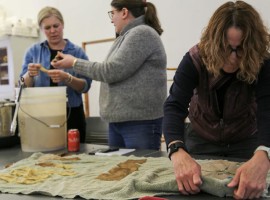CEDIK Celebrates a Decade of Helping Rural Communities Thrive

For 10 years, rural Kentucky communities looking to build dynamic, sustainable economies have turned to the University of Kentucky’s Community and Economic Development Initiative of Kentucky for support. With research-based data, targeted publications, leadership development, coalition-building and networking support, CEDIK has made a difference for many small communities struggling to recover from job losses and an outward migration of residents looking for better opportunities elsewhere.
“CEDIK exemplifies the continuing relevance of our land-grant mission,” said Barry Barnett, chair of the UK Department of Agricultural Economics. “They connect with rural communities to address local challenges using research-based knowledge.”
In 2010, administrators and extension faculty in the UK College of Agriculture, Food and Environment, where CEDIK is based, felt that Kentucky needed a coordinating entity to help communities create economic opportunity and vibrant, enriching lifestyles for their citizens.
“CEDIK is one of the many valuable, all-encompassing services the college offers the people of this state. We recognize that vibrant rural communities are essential for the health of the state’s economy as well as for maintaining a strong agricultural sector,” Dean Nancy Cox said.
Joe Crawford, director of Estill Development Alliance in Irvine, has worked with CEDIK on several strategic planning ventures since its inception.
“It’s invaluable having CEDIK as that hub to follow best practices and do the research and put out resources that, honestly, nobody else is doing. They go that extra mile to make sure that folks in the small communities are getting access to the same resources and education that folks in the big cities are. That’s been amazing,” he said. “We haven’t even begun to tap all the different ways that we’re going to use CEDIK moving forward.”
Over the past 10 years, CEDIK’s role has grown in response to communities’ needs, but CEDIK Director Alison Davis said there’s still a lot of work to be done.
“I am constantly surprised by how nimble our group is, and I appreciate that our team is willing to take calculated risks, and that our college administration gives us the greenlight to pursue new opportunities,” she said.
CEDIK’s strategies for economic development include expanding existing businesses, developing regional clusters, targeting industrial attraction, developing the workforce, promoting entrepreneurship through its partnership with the Kentucky Small Business Development Center, and stimulating the creative class. In partnership with the UK Department of Landscape Architecture, it helps cities address spatial planning and design needs with an emphasis on public spaces.
“I am most proud of our people and our partners,” Davis said. “Where else would I get the opportunity to work daily alongside economists, sociologists, public health leaders, landscape architects, planners, artists and geographers? I take immense pride in our diverse backgrounds. In addition, we would be nowhere without our partners. Whether it is working internally with Family and Consumer Sciences Extension and the Kentucky Office of Rural Health or externally with the Kentucky Association for Economic Development and the Foundation for Appalachian Kentucky, our efforts do not, nor will they ever, operate in a silo.”
CEDIK provides communities with a toolbox of resources, data and programs that gives a community or region the ability to strengthen its relative position and endure shocks to its economy.
“I believe that the biggest challenges facing Kentucky over the next 50 years will relate to health care, education and economic vitality in our rural communities,” Barnett said. “CEDIK is at the forefront in addressing those challenges.”
Crawford said one of the best tools CEDIK provides to communities is county data.
“All the county-specific datasets that have been researched and made available are such an important resource. If communities haven’t been taking advantage of that resource, they need to, because it’s amazing,” he said.
The datasets provide easy-to-understand research reports that communities can use for strategic planning or grant writing.
One of the ways Crawford’s town of Irvine has made use of CEDIK’s support was through First Impressions, a structured assessment program that helps communities learn about their strengths and weaknesses through the eyes of first-time visitors.
“That was very well received by the folks in the community,” he said. “We’ve referenced the data that we received from that multiple times, as we’ve been working on building up our tourism economy.”
As the program celebrates its 10th anniversary, CEDIK personnel look back with pride and forward with determination that Kentucky’s future will shine brightly and serve as an example to other states.
More information about the Community and Economic Development Initiative of Kentucky is available at https://cedik.ca.uky.edu/.





